In the world of agricultural innovation, a significant breakthrough has been unveiled in the field of citrus fruit propagation, specifically focusing on the Kinnow mandarin. The recent study conducted by Mohammed, Yusuf, and Petros sheds light on the intricate process of optimizing micropropagation through the use of shoot tip nodal segments. This advanced technique not only promises to enhance the efficiency of propagation but also aims to boost the overall yield and quality of Kinnow mandarins, a variety recognized for its tangy flavor and nutritional benefits.
Micropropagation, a tissue culture technique, plays a pivotal role in modern agriculture. This approach allows for the rapid multiplication of plants under sterile conditions, ensuring that the new plants maintain the desired traits of the parent plants. The study brings forth detailed insights into the methodologies employed in micropropagation, emphasizing the significance of selecting ideal shoot tip nodal segments for tissue culturing. These segments serve as the foundation for developing new Kinnow mandarin plants that are genetically identical to the originals, thus preserving the unique characteristics of this citrus variety.
One of the core components of the study revolves around the optimization of growth media used during the micropropagation process. Researchers meticulously experimented with various combinations of nutrients, hormones, and growth regulators to create the most conducive environment for the shoot tip nodal segments to thrive. The findings revealed that certain combinations significantly enhanced the growth rate and overall health of the plantlets, leading to a more successful propagation outcome.
In addition to optimizing the growth media, the researchers placed considerable emphasis on controlling environmental parameters. Factors such as light intensity, temperature, and humidity were systematically altered and monitored to ascertain their effects on the micropropagation process. This holistic approach ensured that every conceivable element that could influence plant growth was taken into account, leading to comprehensive and actionable results.
The study also delves into the role of sterilization techniques in preventing contamination during the micropropagation process. Maintaining a sterile environment is paramount in tissue culture, as any foreign microbial presence can jeopardize the entire propagation effort. The authors meticulously outlined various sterilization protocols and their efficacies, providing a valuable road map for future researchers and practitioners in the field.
An intriguing aspect of the research is its consideration of genetic fidelity in the propagated Kinnow mandarin plants. Viable tissue culture should ideally produce plants that are true to type, retaining all the desirable traits of their progenitors. The authors employed molecular techniques to assess genetic variation among the propagated plants, ensuring that the micropropagation process did not introduce any undesirable mutations that could impact yield or fruit quality.
As the global demand for citrus fruits continues to rise, optimizing the propagation of Kinnow mandarin becomes even more critical. The economic implications of enhancing propagation efficiency cannot be overstated, as it directly correlates with increased fruit availability and potentially, lower market prices. This study provides essential insights that can stimulate both smallholding and commercial growers to adopt these innovative practices in their propagation strategies.
The researchers are optimistic that their findings will not only benefit the Kinnow mandarin growers but also provide a framework for micropropagating other citrus varieties. The methodologies outlined could potentially be adapted and fine-tuned for different citrus species, allowing for broader applications across the agricultural sector. This cross-applicability is essential in a landscape where climate change and economic pressures demand increased efficiency and adaptability within farming practices.
The impact of the research extends beyond just agricultural productivity; it also highlights the importance of scientific inquiry in combating food security challenges globally. In a world where crop yields must meet the increasing demands of a growing population, innovations in micropropagation techniques like those presented in this study could represent a crucial step forward in sustainable agricultural practices.
Furthermore, the study overarches the importance of collaborative research in enhancing agricultural techniques. Through the collective expertise of the authors and their institutions, a more significant impact is made than would be possible in isolation. This aspect serves as a call to action for universities, research institutions, and agricultural stakeholders to collaborate in the continuous pursuit of agricultural excellence.
In summary, the research conducted by Mohammed, Yusuf, and Petros serves as a landmark study in the field of micropropagation, positioning Kinnow mandarin as a focal point for future agricultural endeavors. The findings not only advance the science of plant propagation but also emphasize the crucial need for innovative practices that can lead to increased food production worldwide. With its potential applications extending far beyond the laboratory, this study could very well be a game-changer in the quest for higher agricultural yields and sustainable farming methods.
As the agricultural community looks to the future, the results of this meticulous research will undoubtedly shape the pathway for citrus propagation, influencing practices and policies that ensure the continued success of this important crop in the years to come.
Subject of Research: Citrus propagation techniques using micropropagation
Article Title: Optimizing micropropagation of Kinnow mandarin (Citrus reticulata Blanco) from shoot tip nodal segments.
Article References:
Mohammed, A., Yusuf, Z. & Petros, Y. Optimizing micropropagation of Kinnow mandarin (Citrus reticulata Blanco) from shoot tip nodal segments.
Discov Agric 3, 135 (2025). https://doi.org/10.1007/s44279-025-00320-6
Image Credits: AI Generated
DOI: https://doi.org/10.1007/s44279-025-00320-6
Keywords: Micropropagation, Kinnow mandarin, Citrus reticulata, Tissue culture, Sustainable agriculture, Propagation techniques.




